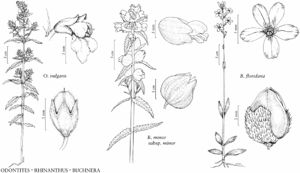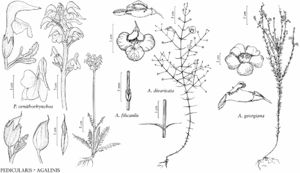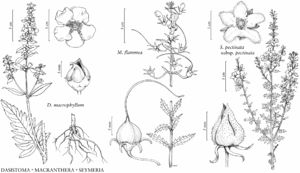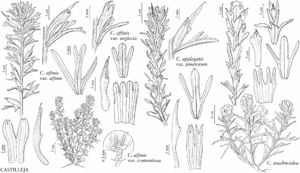Orobanchaceae
Herbs, rarely subshrubs or shrubs, annual, biennial, or perennial, sometimes fleshy, hemiparasitic or holoparasitic (without chlorophyll) [autotrophic]. Stems subterranean or aerial; aerial stems prostrate to decumbent, ascending, or erect [viny]. Leaves deciduous, cauline or basal and cauline, rarely basal only or absent, sometimes scales, opposite, alternate, whorled, or spiral, simple; stipules absent; petiole present or absent; blade usually not fleshy or leathery, rarely fleshy, leathery, or chartaceous, margins entire, toothed, or lobed. Inflorescences terminal and/or axillary, racemes, panicles, spikes, corymbs, or flowers 1 or 2. Flowers bisexual, perianth and androecium hypogynous; sepals (0 or) 2–5 (–8), connate, calyx radially or bilaterally symmetric; petals [4 or] 5, connate, corolla bilaterally symmetric, bilabiate or strongly bilabiate, tubular, funnelform, campanulate, salverform, or club-shaped, sometimes cylindric, subrotate, or curved; stamens (2 or) 4, adnate to corolla-tube, didynamous, subequal, or equal, staminodes 0 or 2; pistil 1, 2 [or 3] -carpellate, ovary superior, 1-locular or 2-locular, placentation axile, sometimes parietal; ovules anatropous or campylotropous-like (Rhinanthus), unitegmic, tenuinucellate; style 1; stigma 1. Fruits capsules, dehiscence loculicidal and/or septicidal or indehiscent (Conopholis). Seeds 1–2500 (–5000), brown or black, sometimes tan, white, yellow, amber, or gray, ovoid to ellipsoid, reniform, globular, oblong, or angled; embryo straight, endosperm present.
Distribution
nearly worldwide, especially in warm temperate regions
Discussion
Genera ca. 100, species ca. 2000 (27 genera, 292 species in the flora).
Orobanchaceae are now defined to include both the holoparasitic members traditionally included in the family (A. Cronquist 1981) and the hemiparasitic genera formerly included in Scrophulariaceae. Although multiple research groups focus on members of the Orobanchaceae, a widely accepted infrafamilial classification of the family in the sense of Angiosperm Phylogeny Group (2016) has not yet appeared.
The classification by J. R. McNeal et al. (2013), who found that Orobanchaceae comprise six clades, is followed herein (their named clades are roughly equivalent to tribes). The autotrophic Lindenbergia Lehmann (12 species in the Old World) corresponds to the basal clade sister to the rest of the clades. Species in our region are distributed among the remaining five clades: Cymbarieae D. Don (genus 1), Orobancheae Lamarck & de Candolle (genera 2–6), Rhinantheae Lamarck & de Candolle (genera 7–12), Buchnereae Bentham (genera 13 and 14), and Pedicularideae Duby (genera 15–27). Within the family, genera are arranged alphabetically within tribes, or within Pedicularideae, in subgroups within the tribe.
Parasitic plants attach to their hosts via haustoria (L. J. Irving and D. D. Cameron 2009). Haustoria are produced by both hemiparasitic and holoparasitic Orobanchaceae (E. Fischer 2004). In hemiparasitic taxa, haustoria usually tap their host’s xylem, mostly taking up water, mineral nutrients, and nitrogen from their host, and sometimes also carbon. Holoparasitic taxa derive all of their growth requirements predominantly from the host’s phloem (Irving and Cameron).
Parasitism has evolved once in the family (N. D. Young et al. 1999; J. R. McNeal et al. 2013); holoparasitism has arisen independently three times from the hemiparasitic condition (J. R. Bennett and S. Mathews 2006; McNeal et al.).
Some Orobanchaceae are serious pests, primarily on legume and grain crops in warmer and drier areas, especially in sub-Saharan Africa. Striga is a particularly serious pest that parasitizes mostly monocots; S. gesnerioides attacks eudicots (K. I. Mohamed et al. 2006). Orobanche parasitizes eudicot crops primarily in temperate parts of the world (E. S. Teryokhin 1997). All Striga species and non-native species of Orobanche in the flora area are listed on the Federal Noxious Weed List (http://www.aphis.usda.gov/plant_health/plant_pest_info/weeds/downloads/weedlist.pdf) in the United States.
Selected References
Lower Taxa
Illustrations
Key
| 1 | Plants holoparasitic, achlorophyllous. | > 2 |
| 2 | Corollas salverform; annuals. | Striga |
| 2 | Corollas short-tubular, tubular, or funnelform; perennials or annuals. | > 3 |
| 3 | Flowers cleistogamous and chasmogamous; petals 5 (appearing as 4); stems absent. | Epifagus |
| 3 | Flowers chasmogamous; petals 5; stems present. | > 4 |
| 4 | Capsules indehiscent; calyces divided abaxially, not divided adaxially; stamens exserted. | Conopholis |
| 4 | Capsules dehiscent; calyces divided roughly uniformly abaxially and adaxially; stamens included. | > 5 |
| 5 | Corollas tinged pink to purple, yellow, or blue, pallid proximally; palatal folds present (longitudinal folds in abaxial side of tube); calyces narrowly campanulate to campanulate; roots short, sometimes coralloid. | Orobanche |
| 5 | Corollas dark red or purple, sometimes yellow; palatal folds absent; calyces cup-shaped; roots absent. | > 6 |
| 6 | Inflorescences dense spikes; pedicels absent, bracteoles absent; corollas short-tubular. | Boschniakia |
| 6 | Inflorescences compact or open racemes; pedicels present, bracteoles present, rarely absent; corollas funnelform. | Kopsiopsis |
| 1 | Plants hemiparasitic, chlorophyllous. | > 7 |
| 7 | Corollas bilabiate, adaxial lips not galeate, cucullate, or beaked. | > 8 |
| 8 | Corollas salverform. | > 9 |
| 9 | Corollas purple, blue-purple, blue, violet, rosy, or white; filaments pilose. | Buchnera |
| 9 | Corollas red, brownish red, or purple, rarely white or yellow; filaments glabrous. | Striga |
| 8 | Corollas tubular, campanulate, or subrotate. | > 10 |
| 10 | Leaves whorled. | Brachystigma |
| 10 | Leaves alternate, opposite, or subopposite. | > 11 |
| 11 | Leaves alternate. | Agalinis |
| 11 | Leaves opposite or subopposite. | > 12 |
| 12 | Corollas pale pink to rose purple or purple, rarely white; leaf blade margins entire, rarely proximally cleft, pinnatifid, or 2-pinnatifid. | Agalinis |
| 12 | Corollas yellow or bright orange; leaf blade margins toothed or irregularly lobed, pinnatifid, or 2-pinnatifid, sometimes entire. | > 13 |
| 13 | Corollas bright orange, tubular; stamens equal. | Macranthera |
| 13 | Corollas yellow, campanulate; stamens didynamous, subequal, or equal. | > 14 |
| 14 | Anthers villous. | Aureolaria |
| 14 | Anthers glabrous. | > 15 |
| 15 | Calyx lobes ovate to oblong-ovate; stamens didynamous. | Dasistoma |
| 15 | Calyx lobes linear to lanceolate; stamens equal to subequal. | Seymeria |
| 7 | Corollas strongly bilabiate or bilabiate, adaxial lips galeate, cucullate, or beaked. | > 16 |
| 16 | Perennials, caudices woody or fleshy. | > 17 |
| 17 | Bracteoles present; sepals 5. | Schwalbea |
| 17 | Bracteoles absent; sepals 2, 4, or 5. | > 18 |
| 18 | Cauline leaves decussate. | Bartsia |
| 18 | Cauline leaves alternate, rarely whorled. | > 19 |
| 19 | Pollen sacs equal; corollas: adaxial lips sometimes with an upcurved or coiled beak. | Pedicularis |
| 19 | Pollen sacs unequal; corollas: adaxial lips straight, rarely hooked. | Castilleja |
| 16 | Annuals, rarely biennials, caudices absent. | > 20 |
| 20 | Cauline leaves opposite, sometimes subopposite or alternate. | > 21 |
| 21 | Leaf blade margins entire, sometimes margins of distal leaves proximally toothed; calyx lobes subulate; seeds 1–4. | Melampyrum |
| 21 | Leaf blade margins toothed; calyx lobes deltate, triangular, or lanceolate; seeds (2–)10–450. | > 22 |
| 22 | Calyces ovate to suborbiculate, flattened laterally, accrescent in fruit. | Rhinanthus |
| 22 | Calyces tubular to campanulate, not flattened laterally, not accrescent in fruit. | > 23 |
| 23 | Anther mucros unequal; capsule dehiscence septicidal. | Euphrasia |
| 23 | Anther mucros equal or absent; capsule dehiscence loculicidal. | > 24 |
| 24 | Filaments glabrous; inflorescences spikelike racemes. | Bellardia |
| 24 | Filaments papillose; inflorescences unilateral racemes. | Odontites |
| 20 | Cauline leaves alternate, proximals rarely subopposite to opposite. | > 25 |
| 25 | Stamens 2. | > 26 |
| 26 | Leaf blades: margins of proximals 3-lobed, margins of distals entire. | Cordylanthus |
| 26 | Leaf blades: margins entire or pinnately 5–11-lobed. | > 27 |
| 27 | Leaf blade margins entire or pinnately 5- or 7-lobed; pollens sacs approximate, connectives not elongate. | Chloropyron |
| 27 | Leaf blade margins pinnately 8–11-lobed; pollens sacs separate, connectives elongate. | Dicranostegia |
| 25 | Stamens 4. | > 28 |
| 28 | Corollas: adaxial lips ± straight, openings directed forward, rarely beaked, bent, or hooked at tip and openings directed downward; stigmas capitate or 2-lobed. | > 29 |
| 29 | Cauline leaves alternate; pollen sacs 2. | Castilleja |
| 29 | Cauline leaves: proximals usually subopposite to opposite, distals alternate; pollen sacs 1. | Triphysaria |
| 28 | Corollas: adaxial lips rounded at apex, sometimes obscurely so, openings directed downward; stigmas not or slightly expanded. | > 30 |
| 30 | Sepals 4, calyces tubular. | Orthocarpus |
| 30 | Sepals 2, calyces spathelike. | > 31 |
| 31 | Leaf blade margins entire; corollas: middle lobes of abaxial lips not revolute; saline marshes, alkaline flats. | Chloropyron |
| 31 | Leaf blade margins entire or 3–7-lobed; corollas: middle lobes of abaxial lips tightly revolute; sagebrush scrub, chaparral, woodlands, forests. | Cordylanthus |



























